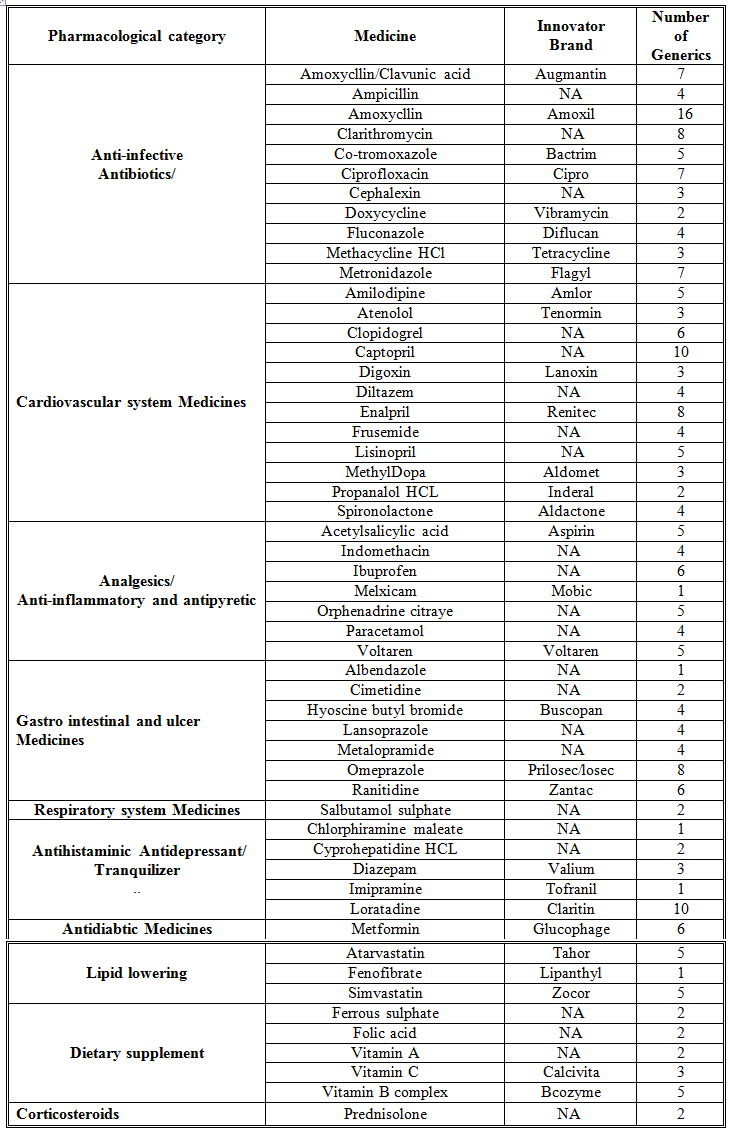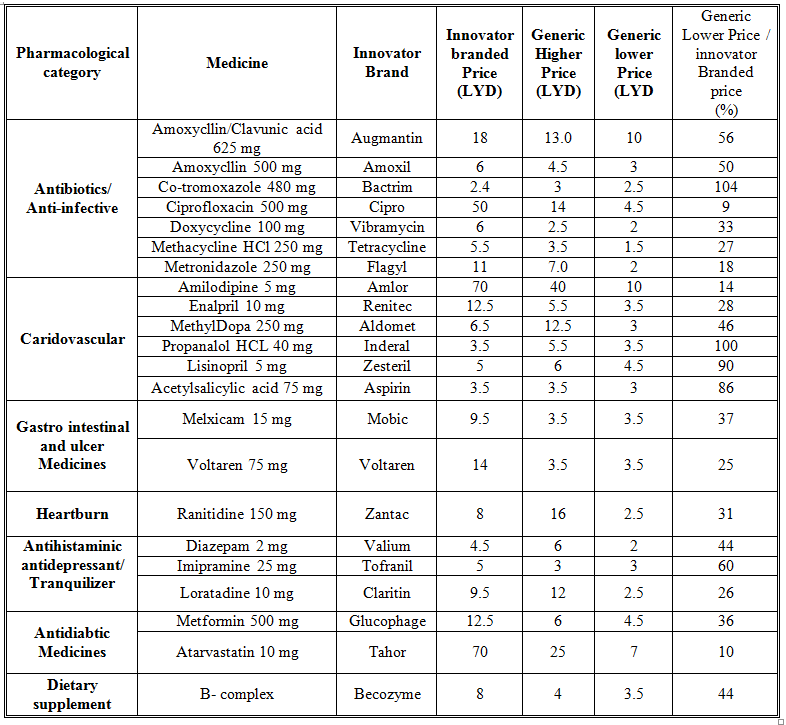{ DOWNLOAD AS PDF }
ABOUT AUTHORS
Hanan. M. El Bsir1, Mokhtar. M. El-Baseir2, Abdulrhman .A . Akasha2*, Somaia.A . Elsaedi3 and Abdrheam Eluzy2.
1National Medical Research Center,
Zawia, Libya
2Department of Pharmaceutics,
Faculty of Pharmacy, University of Tripoli, Libya
3Minstry of Health,
Tripoli, Libya
ABSTRACT
This paper presents a survey study of generic and branded medicines available on the local market. The study was carried out on solid dosage forms (Tablets and capsules) for 53 medications available at the time of study in 69 pharmacies located in Tripoli, Libya. Physical specifications (generic name, batch number, manufacture date, expiry date and the manufacturer) as appeared on the package for each product were recorded in a designed form. The retail price at the time of study for each innovator brand and the counterpart generic was also recorded and compared. Results showed that 234 (89%) generics and 29 (11%) branded medicines were available for the studied medicines. The generics medicines were antibiotics (28%), cardiovascular (24.36%), analgesics and antipyretics (12.5%), gastrointestinal (12.8%), for respiratory tract (0.85%), anti-Anthistamin (7.26%), for adiabatic (3%), for vitamins and minerals (6%) and corticosteroid (1%) medicines. The original suppliers of the generics were European countries (42%), Arabian countries (41%) and other region of the world (17%). The retail prices for the generics were significantly (p > 0.05) lower compared to the price of innovator brand counterpart. The study suggests post-marketing surveillance studies for the available generics in comparison to the innovators especially in terms of therapeutic efficiency.
Reference Id: PHARMATUTOR-ART-2617
|
PharmaTutor (Print-ISSN: 2394 – 6679; e-ISSN: 2347 – 7881) Volume 6, Issue 10 Received On: 28/08/2018; Accepted On: 14/09/2018; Published On: 01/10/2018 How to cite this article: El Bsir, H., El-Baseir, M., Elsaedi, S., Akasha, A. and Eluzy, A. 2018. Generic Versus Branded Medicines Available on the Local Market. PharmaTutor. 6, 10 (Oct. 2018), 5-12. DOI:https://doi.org/10.29161/PT.v6.i10.2018.5 |
Methodology
This study involved a survey of generic and branded medicines available on the local privet market, Tripoli, Libya. The study was performed during the shift hours of 69 pharmacies located in different area of Tripoli. In order to avoid any adherence in data, no previous notes about the aim of the study was give to the pharmacies. Generic name, batch number, manufacture date, expiry date, strength and manufacturer name as appeared on the package for each medicament were recorded in predesigned forum. The local sale price for each drug at the time of study was also recorded and compared.
Data analysis
Data were analysed with Excel Version 2010.The number of generics for each dosage form (tablets and capsules) was recorded. The ratios of generics to innovators available for each drug were estimated. The price for the available innovator was compared to the lower sale price for the corresponding generic. The generics then classified according to their pharmacological group and compared. Two-sample t-test was used to test the significance of the difference in change in the measurement between the two groups was applied in comparison of data. The results of this study were expressed as % (95% Confidence Intervals (CI)). Variations were evaluated using the one-way analysis of variance (ANOVA) and
P≤0.05 was considered statistically significant.
Results
Overall, 53 medicines were surveyed in 69 pharmacies. The study revealed that 234 (89%) generics versus 29 (11%) innovators were available at the time of study for these medicines. Table 1 illustrates the generics and counterpart innovator brand for each medicine. The available generics were antibiotics (28%), analgesics and antipyretics (13%), gastrointestinal drugs (12%), cardiovascular systems (24%), respiratory tract infection treatment drugs (0.85%), anti-histamine (7%), anti-diabetic (2.5%), lipid lowering (5%), dietary supplement (6%) and corticosteroids (0.9%) drugs. Figure 1 shows the innovator brands (%) relative to the number of medicine for each pharmacological category. The highest innovator was for lipid lowering (22%) with lowest was for respiratory tract system with (0%) among other studied items. In contrast generics (%) were between 100 % for respiratory tract and 80% for Lipid lowering medicines respectively (Fig 2). Contrasting the total available generics for each pharmacological category to total number of generics showed that Antibiotic generics were with the highest percentage (28%) and respiratory and corticosteroids with the lowest (1%) available among other generics (Fig 3). Table 2 shows the local price for generics and their counterpart innovator brands for 23 medicines. Comparison study showed that 95% of generics were priced lower than their counterpart branded innovator. Two generics (5%) had similar prices to the innovator indicating that none of generics were priced more than the counterpart innovator. The prices of generics on an average were significantly lower than the innovator brands prices. In order to avoid any biased error due to different packaging systems, the prices of generics were also compared based on the unit price. Table 3 shows the unit prices for 21 medicines (generics and counterpart innovator brand) for different pharmacological categories. Results showed that the price of generic was always lower than the innovator price.
Table 1. Generic and innovator branded medicines available on the local market

Table 2. Generic to Innovator Brand Price Differences

LYD = Libyan Dinar
NOW YOU CAN ALSO PUBLISH YOUR ARTICLE ONLINE.
SUBMIT YOUR ARTICLE/PROJECT AT editor-in-chief@pharmatutor.org
Subscribe to Pharmatutor Alerts by Email
FIND OUT MORE ARTICLES AT OUR DATABASE


